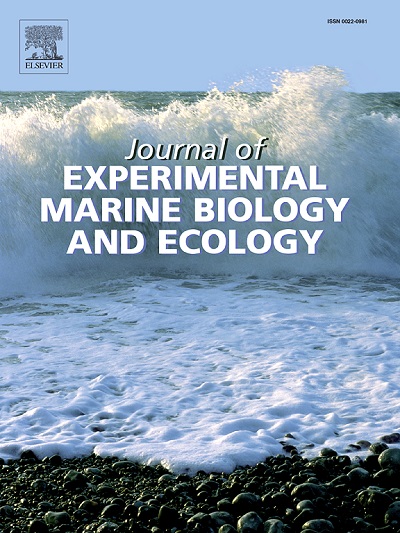海洋雪粒分布和密度梯度对太平洋蛤觅食行为的影响
IF 1.8
3区 生物学
Q3 ECOLOGY
Journal of Experimental Marine Biology and Ecology
Pub Date : 2025-09-29
DOI:10.1016/j.jembe.2025.152137
引用次数: 0
摘要
桡足类动物在食物网的能量传递中起着至关重要的作用,它们经常展示觅食策略,使它们能够利用海洋雪层等斑块状猎物环境。由于海洋雪层与野外密度梯度同时发生,我们通过将太平洋蛤暴露于不同海洋雪分布以及有无密度分层的处理中,评估了每种情况对桡足类觅食行为的影响。在实验室使用二维和三维成像记录游泳行为。我们观察到,在两种密度梯度处理中——有海洋雪层(利用密度梯度产生)的处理和没有海洋雪的处理——桡足类在池中央的停留时间显著增加,尽管海洋雪层存在时桡足类的积累更为强烈。两种密度梯度处理下,桡足类在池中央的跳跃频率较高,垂直速度较低。肠道含量分析表明,桡足类动物在暴露于海雪层和团聚体分布均匀的情况下摄食海洋雪,可能在海雪层处理时摄食量更高。这些结果表明,密度梯度可能作为主要的物理线索,而化学线索的存在具有潜在的次要作用。对这些线索的行为反应使桡足类动物能够找到并留在海洋雪层中,从而深入了解这些相互作用如何破坏海洋雪的下沉,而海洋雪将碳运送到深海。本文章由计算机程序翻译,如有差异,请以英文原文为准。
The effect of marine snow particle distribution and density gradients on the foraging behavior of Calanus pacificus
Copepods play a critical role in transferring energy up the food web and can often exhibit foraging strategies that allow them to capitalize on patchy prey environments such as marine snow layers. Since marine snow layers co-occur with density gradients in the field, we evaluated how each of these affected copepod foraging behavior by exposing Calanus pacificus to treatments with different distributions of marine snow and with and without density stratification. Swimming behavior was recorded in the lab using imaging in 2D and 3D. We observed significantly higher residence time of copepods in the middle of the tank in the two treatments with a density gradient – both the one with a marine snow layer (which is created using a density gradient) and the one without marine snow – although the accumulation of copepods was more intense when the marine snow layer was present. Copepods also exhibited higher jump frequency and lower vertical velocity in the middle of the tank in the two treatments with a density gradient. Gut content analysis showed that copepods ingested marine snow when exposed to the marine snow layer and the homogenous distribution of aggregates, with possibly higher ingestion in the layer treatment. These results suggest that density gradients may act as a primary physical cue – with the presence of chemical cues having a potential secondary effect. Behavioral responses to these cues allow copepods to find and remain in marine snow layers, providing insight into how these interactions can disrupt the sinking of marine snow, which transports carbon to the deep ocean.
求助全文
通过发布文献求助,成功后即可免费获取论文全文。
去求助
来源期刊
CiteScore
4.30
自引率
0.00%
发文量
98
审稿时长
14 weeks
期刊介绍:
The Journal of Experimental Marine Biology and Ecology provides a forum for experimental ecological research on marine organisms in relation to their environment. Topic areas include studies that focus on biochemistry, physiology, behavior, genetics, and ecological theory. The main emphasis of the Journal lies in hypothesis driven experimental work, both from the laboratory and the field. Natural experiments or descriptive studies that elucidate fundamental ecological processes are welcome. Submissions should have a broad ecological framework beyond the specific study organism or geographic region.
Short communications that highlight emerging issues and exciting discoveries within five printed pages will receive a rapid turnaround. Papers describing important new analytical, computational, experimental and theoretical techniques and methods are encouraged and will be highlighted as Methodological Advances. We welcome proposals for Review Papers synthesizing a specific field within marine ecology. Finally, the journal aims to publish Special Issues at regular intervals synthesizing a particular field of marine science. All printed papers undergo a peer review process before being accepted and will receive a first decision within three months.

 求助内容:
求助内容: 应助结果提醒方式:
应助结果提醒方式:


